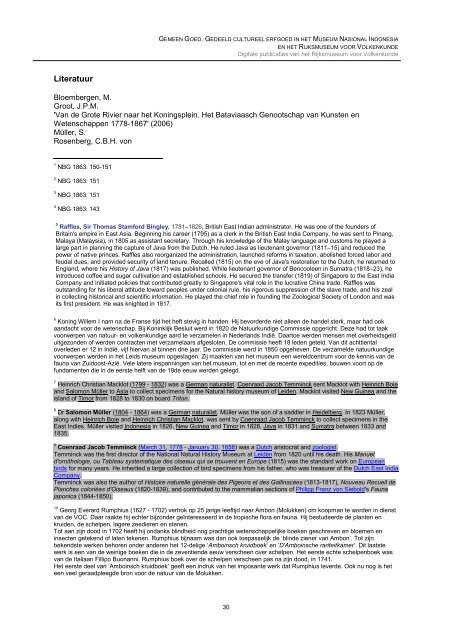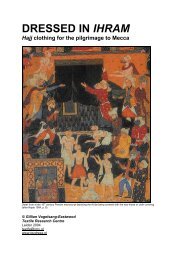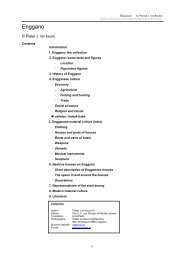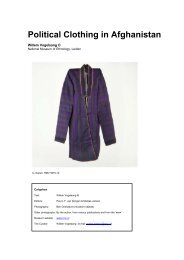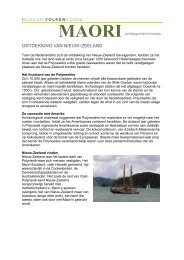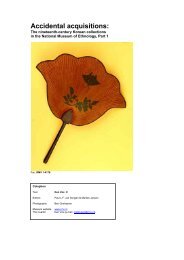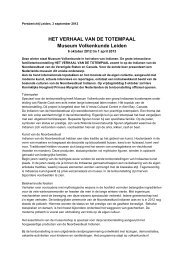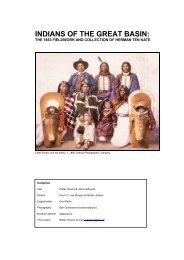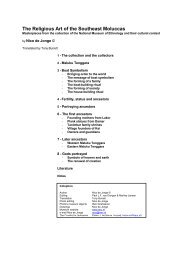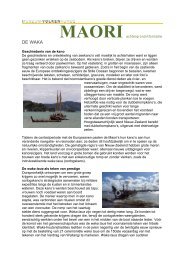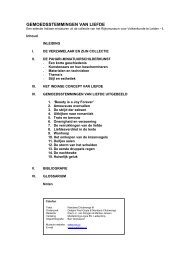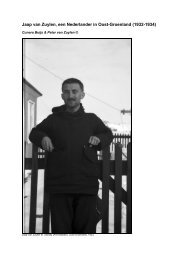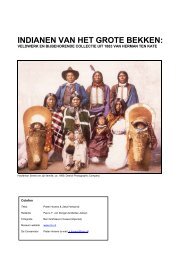Lees de pdf - Museum Volkenkunde
Lees de pdf - Museum Volkenkunde
Lees de pdf - Museum Volkenkunde
Create successful ePaper yourself
Turn your PDF publications into a flip-book with our unique Google optimized e-Paper software.
GEMEEN GOED. GEDEELD CULTUREEL ERFGOED IN HET MUSEUM NASIONAL INDONESIA<br />
EN HET RIJKSMUSEUM VOOR VOLKENKUNDE<br />
Digitale publicaties van het Rijksmuseum voor Volkenkun<strong>de</strong><br />
Literatuur<br />
Bloembergen, M.<br />
Groot, J.P.M.<br />
'Van <strong>de</strong> Grote Rivier naar het Koningsplein. Het Bataviaasch Genootschap van Kunsten en<br />
Wetenschappen 1778-1867' (2006)<br />
Müller, S.<br />
Rosenberg, C.B.H. von<br />
1 NBG 1863: 150-151<br />
2 NBG 1863: 151<br />
3 NBG 1863: 151<br />
4 NBG 1863: 143<br />
5 Raffles, Sir Thomas Stamford Bingley, 1781–1826, British East Indian administrator. He was one of the foun<strong>de</strong>rs of<br />
Britain's empire in East Asia. Beginning his career (1795) as a clerk in the British East India Company, he was sent to Pinang,<br />
Malaya (Malaysia), in 1805 as assistant secretary. Through his knowledge of the Malay language and customs he played a<br />
large part in planning the capture of Java from the Dutch. He ruled Java as lieutenant governor (1811–15) and reduced the<br />
power of native princes. Raffles also reorganized the administration, launched reforms in taxation, abolished forced labor and<br />
feudal dues, and provi<strong>de</strong>d security of land tenure. Recalled (1815) on the eve of Java's restoration to the Dutch, he returned to<br />
England, where his History of Java (1817) was published. While lieutenant governor of Bencooleen in Sumatra (1818–23), he<br />
introduced coffee and sugar cultivation and established schools. He secured the transfer (1819) of Singapore to the East India<br />
Company and initiated policies that contributed greatly to Singapore's vital role in the lucrative China tra<strong>de</strong>. Raffles was<br />
outstanding for his liberal attitu<strong>de</strong> toward peoples un<strong>de</strong>r colonial rule, his rigorous suppression of the slave tra<strong>de</strong>, and his zeal<br />
in collecting historical and scientific information. He played the chief role in founding the Zoological Society of London and was<br />
its first presi<strong>de</strong>nt. He was knighted in 1817.<br />
6 Koning Willem I nam na <strong>de</strong> Franse tijd het heft stevig in han<strong>de</strong>n. Hij bevor<strong>de</strong>r<strong>de</strong> niet alleen <strong>de</strong> han<strong>de</strong>l sterk, maar had ook<br />
aandacht voor <strong>de</strong> wetenschap. Bij Koninklijk Besluit werd in 1820 <strong>de</strong> Natuurkundige Commissie opgericht. Deze had tot taak<br />
voorwerpen van natuur- en volkenkundige aard te verzamelen in Ne<strong>de</strong>rlands Indië. Daartoe wer<strong>de</strong>n mensen met overheidsgeld<br />
uitgezon<strong>de</strong>n of wer<strong>de</strong>n contracten met verzamelaars afgesloten. De commissie heeft 18 le<strong>de</strong>n geteld. Van dit achttiental<br />
overle<strong>de</strong>n er 12 in Indië, vijf hiervan al binnen drie jaar. De commissie werd in 1850 opgeheven. De verzamel<strong>de</strong> natuurkundige<br />
voorwerpen wer<strong>de</strong>n in het Leids museum opgeslagen. Zij maakten van het museum een wereldcentrum voor <strong>de</strong> kennis van <strong>de</strong><br />
fauna van Zuidoost-Azië. Vele latere inspanningen van het museum, tot en met <strong>de</strong> recente expedities, bouwen voort op <strong>de</strong><br />
fundamenten die in <strong>de</strong> eerste helft van <strong>de</strong> 19<strong>de</strong> eeuw wer<strong>de</strong>n gelegd.<br />
7 Heinrich Christian Macklot (1799 - 1832) was a German naturalist. Coenraad Jacob Temminck sent Macklot with Heinrich Boie<br />
and Salomon Müller to Asia to collect specimens for the Natural history museum of Lei<strong>de</strong>n. Macklot visited New Guinea and the<br />
island of Timor from 1828 to 1830 on board Triton.<br />
8 Dr Salomon Müller (1804 - 1864) was a German naturalist. Müller was the son of a saddler in Hei<strong>de</strong>lberg. In 1823 Müller,<br />
along with Heinrich Boie and Heinrich Christian Macklot, was sent by Coenraad Jacob Temminck to collect specimens in the<br />
East Indies. Müller visited Indonesia in 1826, New Guinea and Timor in 1828, Java in 1831 and Sumatra between 1833 and<br />
1835.<br />
9 Coenraad Jacob Temminck (March 31, 1778 - January 30, 1858) was a Dutch aristocrat and zoologist.<br />
Temminck was the first director of the National Natural History <strong>Museum</strong> at Lei<strong>de</strong>n from 1820 until his <strong>de</strong>ath. His Manuel<br />
d'ornithologie, ou Tableau systematique <strong>de</strong>s oiseaux qui se trouvent en Europe (1815) was the standard work on European<br />
birds for many years. He inherited a large collection of bird specimens from his father, who was treasurer of the Dutch East India<br />
Company.<br />
Temminck was also the author of Histoire naturelle générale <strong>de</strong>s Pigeons et <strong>de</strong>s Gallinacées (1813-1817), Nouveau Recueil <strong>de</strong><br />
Planches coloriées d'Oiseaux (1820-1839), and contributed to the mammalian sections of Philipp Franz von Siebold's Fauna<br />
japonica (1844-1850).<br />
10 Georg Everard Rumphius (1627 - 1702) vertrok op 25 jarige leeftijd naar Ambon (Molukken) om koopman te wor<strong>de</strong>n in dienst<br />
van <strong>de</strong> VOC. Daar raakte hij echter bijzon<strong>de</strong>r geïnteresseerd in <strong>de</strong> tropische flora en fauna. Hij bestu<strong>de</strong>er<strong>de</strong> <strong>de</strong> planten en<br />
krui<strong>de</strong>n, <strong>de</strong> schelpen, lagere zeedieren en stenen.<br />
Tot aan zijn dood in 1702 heeft hij ondanks blindheid nog prachtige wetenschappelijke boeken geschreven en bloemen en<br />
insecten getekend of laten tekenen. Rumphius bijnaam was dan ook toepasselijk <strong>de</strong> ‘blin<strong>de</strong> ziener van Ambon’. Tot zijn<br />
bekendste werken behoren on<strong>de</strong>r an<strong>de</strong>ren het 12-<strong>de</strong>lige ‘Amboinsch kruidboek’ en ‘D'Amboinsche rariteitkamer’. Dit laatste<br />
werk is een van <strong>de</strong> weinige boeken die in <strong>de</strong> zeventien<strong>de</strong> eeuw verscheen over schelpen. Het eerste echte schelpenboek was<br />
van <strong>de</strong> Italiaan Fillipo Buonanni. Rumphius boek over <strong>de</strong> schelpen verscheen pas na zijn dood, in 1741.<br />
Het eerste <strong>de</strong>el van ‘Amboinsch kruidboek’ geeft een indruk van het imposante werk dat Rumphius lever<strong>de</strong>. Ook nu nog is het<br />
een veel geraadpleeg<strong>de</strong> bron voor <strong>de</strong> natuur van <strong>de</strong> Molukken.<br />
30


